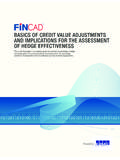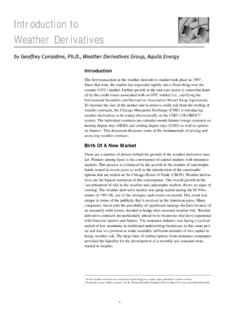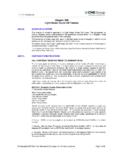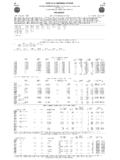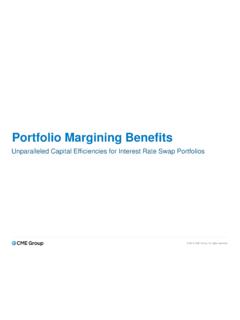Transcription of The basics of accounTing for derivaTives and hedge …
1 The basics of accounTing for derivaTives and hedge accounTing This is the first paper in an ongoing series that outlines the principles of hedge accounTing under current and expected International and accounTing standards, including the practical challenges typically faced by organizations. Prepared by The basics of accounTing for derivaTives and hedge accounTing In the regular course of business operations, organizations are exposed to market risks such as interest rate risk, foreign exchange risk, commodity price risk, etc., that give rise to income volatility. As a result, organizations often will take some action to mitigate or economically hedge against such exposures using derivative financial instruments.
2 In addition some organizations may enter into derivative contracts for speculative or trading purposes. accounTing for Derivative Instruments Under current and International accounTing standards, an entity is required to measure derivative instruments at fair value, or mark-to-market (MTM), with changes in fair value or MTM to be recognized through the income statement. Fair value is defined under accounTing standards as the price that would be received to sell an asset, or paid to transfer a liability in an orderly transaction between market participants at the measurement date. International accounTing standards define fair value slightly differently as the amount for which an asset could be exchanged, or a liability settled, between knowledgeable, willing parties in an arm's length transaction.
3 Non-performance risk or the risk that an obligation will not be fulfilled (also known as credit risk) is also required to be incorporated into the fair value measurement. While the definitions differ, the principle is generally the same in the and internationally. hedge accounTing The accounTing for derivative instruments at fair value creates a common issue for organizations that hedge risks using such instruments. Specifically, such organizations may face an accounTing mismatch between the derivative instrument which is measured at fair value, and the underlying exposure being hedged, as typically underlying exposures are recognized assets or liabilities that are accounted for on a cost or an amortized cost basis, or future transactions that have yet to be recognized.
4 This accounTing mismatch results in volatility in the financial statements as there is no offset to the change in the fair value of the derivative instrument. hedge accounTing provides this offset by effectively eliminating/reducing the accounTing mismatch through one of three ways: 1. through a Fair Value hedge , which is achieved by accounTing for the underlying exposure, asset or liability (typically referred to as the hedged item) by adjusting the carrying value for changes in the hedged risk, which would then offset, to the extent effective, the change in the fair value of the derivative instrument, or 2. through a Cash Flow hedge where changes in the fair value of the derivative instrument are deferred in shareholders equity, to the extent effective, until the underlying exposure impacts the income statement in the future, or 3.
5 Through a Net Investment hedge , which is a variation on a cash flow hedge , used to hedge foreign exchange risk associated with net investments in foreign currency denominated operations. 2. The basics of accounTing for derivaTives and hedge accounTing 1. Fair Value hedge A Fair Value hedge is used when an entity is looking to eliminate or reduce the exposure that arises from changes in the fair value of a financial asset or liability (or other eligible exposure) due to changes in a particular risk, such as interest rate risk on a fixed rate debt instrument. The hedged item is permitted to be measured at fair value each period in respect of the hedged risk (not for all risks), even if the hedged item is normally measured at amortized cost.
6 Any resulting adjustment to the carrying amount of the hedged item related to the hedged risk is recognized in profit or loss, even if such a change normally would be recognized in Other Comprehensive Income (OCI) - for example in the case of an instrument classified as available for sale. The Fair Value hedge Measurement of Derivative Instrument Change in Fair Value +/- Measurement of Hedged Item Income Chage in Fair Value Statement attributable to +/- risk hedged 2. Cash Flow hedge A Cash Flow hedge is used when an entity is looking to eliminate or reduce the exposure that arises from changes in the cash flows of a financial asset or liability (or other eligible exposure) due to changes in a particular risk, such as interest rate risk on a floating rate debt instrument.
7 The hedged item is accounted for under normal principles. The hedging derivative instrument is measured at fair value each period however the effective portion of the change in fair value is deferred in OCI and presented within equity (normally in a hedging reserve). The difference between the effective portion of the change in the fair value of the derivative hedging instrument and the full change in the fair value (the ineffective portion) is recognized immediately in profit or loss. A Cash Flow hedge only has measured ineffectiveness where the change in the fair value of the derivative instrument exceeds the change in the present value of the future cash flows of the hedged item/exposure (referred to as an over hedge ).
8 The change in fair value of the hedging instrument that is deferred in OCI is reclassified to profit or loss at a future date when the hedged item affects profit or loss (for example, when the interest payment on a floating rate debt instrument is made or when the payment associated with an anticipated transaction occurs). The Cash Flow hedge Measurement of Derivative Recognition Change in Effective OCI. Fair Value portion (Shareholders'. Equity). Ine f po fecti rtio ve n *. Income Statement * Amounts are subsequently transferred out of OCI based on the same timing as the hedged item impacts income (interest 3. income, interest expense, etc.). The basics of accounTing for derivaTives and hedge accounTing 3. Net Investment hedge A Net Investment hedge is a specific type of foreign currency cash flow hedge that is used to eliminate or reduce the foreign currency exposure that arises from an entity's Net Investment in a Foreign Operation (NIFO).
9 Upon consolidation each period of the NIFO into the parent financial statements, a foreign currency gain or loss is recognized in shareholders' equity (part of the cumulative translation account). A Net Investment hedge can be used to eliminate or reduce this volatility in shareholders'. equity. The hedging instrument in a Net Investment hedge can either be a derivative instrument (such as a foreign exchange forward contract) or a non-derivative instrument (such as a foreign currency denominated debt instrument), or a combination of a derivative and non-derivative under international accounTing principles. When a derivative hedging instrument is used, the effective portion of the change in the fair value of the instrument is recognized in equity.
10 The ineffective portion is recognized immediately in profit or loss. Similarly, when a non-derivative instrument is used, the foreign currency translation gain or loss is recognized in equity (as opposed to profit or loss). The Net Investment hedge Measurement of Derivative Recognition Net Investment in Foreign Operation Change in Effective Shareholders' Foreign Currency Fair Value Portion Equity Gain / Loss Ine Po ffect rti ive on *. Income Statement * Amounts are subsequently transferred out of Shareholders' Equity in the same period during which corresponding exchange gains or losses arising from the translation of the financial statements of the foreign operation are recognized in net income. 4. The basics of accounTing for derivaTives and hedge accounTing Qualifying for hedge accounTing Documentation There are three basic requirements that must be satisfied in order for hedge accounTing to be applied to any eligible hedge relationship: 1.

